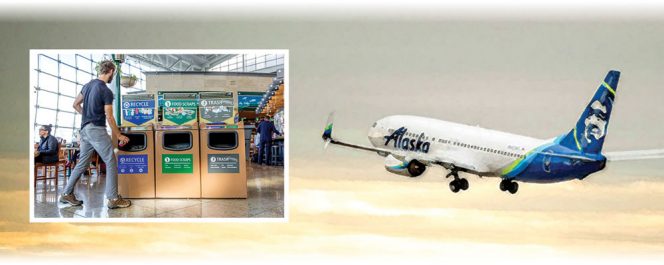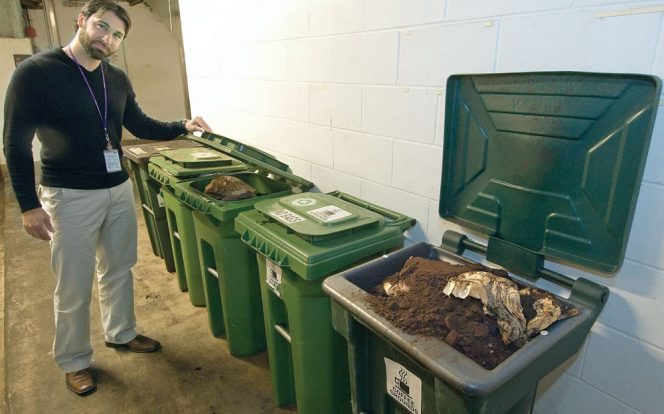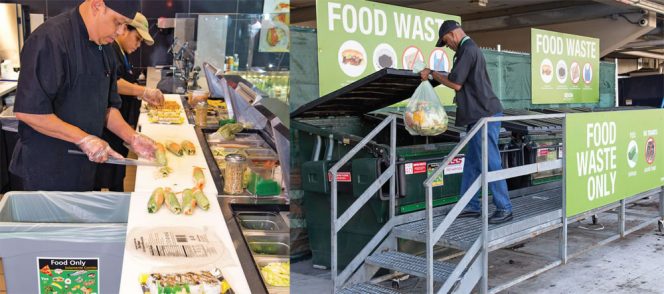Where local infrastructure exists, systems are being put in place to make composting an easy addition to waste diversion programs.
Katrina Mendrey
BioCycle June 2017

SEA-TAC International Airport, servicing Seattle, accepts pre and postconsumer food waste from concessionaires and at public kiosks (above) in concourse food courts.
But for airlines traveling around the country and world it’s not that easy to plug into local organics diversion programs. Systems in place at one airport might not apply at the next destination. Differences in hauling, tipping fees, tarmac space dedicated to waste diversion and what can be composted create an environment that can be confusing.
“Airports operate locally, and airlines operate nationally so it’s an ongoing challenge,” observes Jeremy Webb, Aviation Environmental Program Manager for the Port of Seattle. Webb manages organics recycling at SEA-TAC International Airport, which has had a composting program in place since 2002. It started out with coffee grounds, and now includes pre and postconsumer food waste collected from concessionaires and public kiosks in concourse food courts. Webb estimates that 430 tons of organics are diverted annually through these initiatives.
While he recognizes that a majority of the airport waste diversion the Port supports happens inside the terminals, SEA-TAC has attempted to increase airfield and airline diversion. “We work with the airlines to separate compostables and divert waste,” explains Webb. “We try to make it easy and think about how we can leverage our economies of scale,” adding that each airline is individually responsible for arranging disposal of their waste with service providers.
In 2010, SEA-TAC built a new airfield collection system for airlines and tarmac users, which included 12 compactors, six for recycling and six for garbage. With each visit the compactors can record who is dropping materials and when, which allows the airport to estimate amounts by user. This eliminated multiple garbage receptacles and haulers, reducing traffic and decreasing costs.
Airlines are asked to use the airport’s organics collection dumpsters placed at multiple locations within SEA-TAC. “Vendors dispose of their preconsumer organics in these dumpsters,” explains Webb. “The janitorial company also disposes of postconsumer organics collected in food court and office pantry areas using these dumpsters. Cedar Grove Composting collects organics between one and three times weekly depending on activity levels.” The organics are hauled to Cedar Grove’s facility in Maple Valley, about 17 miles away.
Airlines Participation
Only Alaska and its affiliate Horizon, divert organics into airport organics containers in Seattle, adds Webb. They are two of only a few airlines in the U.S. currently participating in some degree of organics recycling. Another is Sun Country Airlines, which began in-flight organics collection service in late 2016 (see ”Collecting In-Flight Compostables,” February 2017).
Horizon has been collecting coffee grounds since the 1980s and uses SEA-TAC’s organics collection facility to drop brewed grounds between flights. Alaska, which also collects only coffee grounds in-flight, sends its grounds off the plane with the galley carts. According to Kathy Hues, Alaska Airlines Food and Beverage Specialist, about 500,000 pounds of brewed coffee grounds are composted annually from Alaska flights. More of its in-flight food waste is diverted to composting, depending on the kitchen where galley carts are taken once they leave the plane.
“We contract with several kitchens to provide our food services,” explains Hues. “For some like Los Angeles, it’s cheaper for them to divert organics to composting than the landfill so they might do the separation back at the kitchen. But many of our destinations don’t have a composting option.” In addition, Hues reports that while Alaska Airlines has kept to coffee grounds in-flight, a few flight attendants will include the occasional banana peel, especially those comfortable with composting.
Alaska Airlines relies on participation from flight attendants to make the process work. “We started boarding the BioBags we use to collect grounds in 2015,” adds Hues. “But we tested the bags with different flight attendants for two years prior. The flight attendants would voluntarily use them and send us feedback on how they worked. It was a good way to get it out there that this was something we would be doing and get the best procedures in place.”
Beth Stern, a flight attendant for Alaska Airlines, was eager to participate from the beginning. Stern has been a flight attendant with Alaska since 1998 and is on her third worm bin at home since 1995. She says her enthusiasm, however, wasn’t necessarily matched by all of her coworkers. “They all want to do the right thing, but like anything you get a little push back when something changes. They just want to know their efforts aren’t in vain.” But Stern, who has attended Alaska Airline’s waste sorts in Portland, knows the composting is actually taking place.
“It makes sense to focus on coffee grounds as there isn’t that ick factor on top of everything else,” notes Stan Jones, Senior Land Quality Manager at the Port of Portland, which has had an organics separation program in place since 2003. Like Webb, Jones understands the airlines’ waste management limitations, but tries to be supportive if an airline shows interest. “For airlines it is difficult to come up with a one size fits all program,” he explains. “We try to partner with airlines but unless requirements are in the airport agreements, airlines don’t have to follow suit.” These agreements, adds Jones, are challenging to negotiate and to date have not included sustainable materials management language.
Hartsfield-Jackson’s Green Acres
Lack of composting facilities, haulers and a local culture where everything is disposable create obstacles for airports to initiate waste diversion programs. Hartsfield-Jackson Atlanta International Airport (Hartsfield-Jackson) is tackling one of these obstacles by building its own composting facility as part of a project called Green Acres. The airport itself currently has no viable options for composting; the nearest facilities are 110 and 80 miles away in opposite directions. According to Liza Milagro, Senior Sustainability Manager at Hartsfield-Jackson, the airport recognized this was not a cost-effective option and decided to create opportunities not just for the airport, but for Atlanta as a community.
The Green Acres facility will be a 39-acre campus located near the airport on airport-owned land. Thirty acres will be devoted to processing airport organics and recycled materials, along with additional recyclables and organics from the Atlanta Metro area; nine acres will serve as an educational facility for the public. As planned, it will process 22,000 tons of passenger generated terminal waste and 15,000 tons from cargo annually. In addition, 20,000 tons of residential yard trimmings from Atlanta will be used as feedstock to compost with organic residuals collected from the terminal and back of house food service operations. Additional waste streams from outside of the airport will also be accepted to allow the facility to operate at the most efficient capacity of between 180,000 to 210,000 tons annually. Waste accepted from outside sources, however, will have to be similar to that produced by the airport to keep the process streamlined.
Contract approval is anticipated by June 30, 2017. Once a contract is signed, the operator will have 300 days to complete the facility and be ready to accept material. Milagro is hopeful it will be awarded soon and the facility will be operating by late 2018.
As the world’s busiest airport serving 265,000 passengers a day with flights every 30 to 45 seconds, Hartsfield-Jackson has the opportunity to make a big impact in a state with only a few public composting facilities and a network of international travelers. Milagro is quick to recognize both the opportunities and the challenges Hartsfield-Jackson faces in achieving its goal of a 90 percent reduction in waste by 2020, particularly when it comes to organic residuals. “Under the leadership of Mayor Kasim Reed, we are working to become the most sustainable airport in the world. We are the busiest airport in the world so our impact can be huge,” notes Milagro.
She contends the airport recognizes its role in creating sustainable change and wants to do the right thing. “We are working on the subcultural and behavioral changes and taking a tiered approach to creating that change,” adds Milagro, who notes there are several opportunities to increase awareness and get the process started even if they can’t currently collect and compost organics.
Initiatives at Hartsfield-Jackson to reduce waste include increasing the number of recycling receptacles and branding them in a way to, as Milagro says, “make sustainability sexy.” Its overall sustainability campaign will be shared with passengers on billboards and via videos throughout the concourses.
Thinking long-term, the airport has already written requirements for compostable products into new service agreements. This is part of a larger Sustainable Food Court Initiative, where concessionaires will be required to separate back of the house food scraps once a facility is built. According to Milagro, additional kiosks will be available for passengers to divert postconsumer organics in addition to the recycling collection currently offered. Like standard trash container servicing, she estimates organics will be picked up on the same schedule as recycling, about every two hours. Back of the house organics will be picked up first thing in the morning quickly after they are produced.
Milagro, who sees waste as a commodity, is hopeful that once composting within the airport is in place, the service will bleed over to airlines, having a cascading effect. “If we can figure out a good method inside, we can take that to the airlines and create a scenario of more commodity, more volume, less waste,” she explains. “This airport’s economics of scale are huge. Trash is cash.”
Katrina Mendrey is a BioCycle Contributing Editor and program coordinator at Montana State University’s Western Agriculture Research Center in Corvallis, Montana. She can be reached at kmendrey@montana.edu












